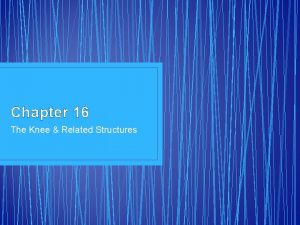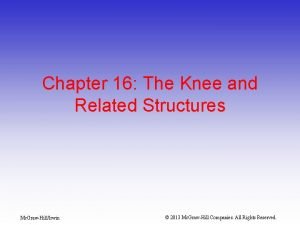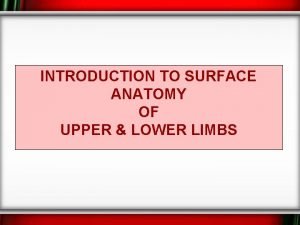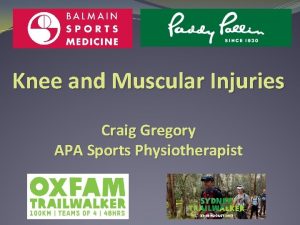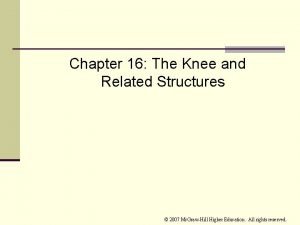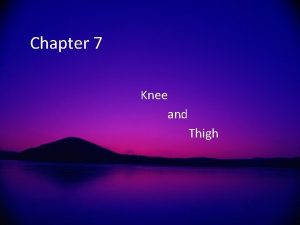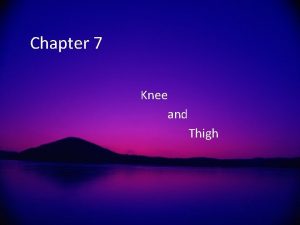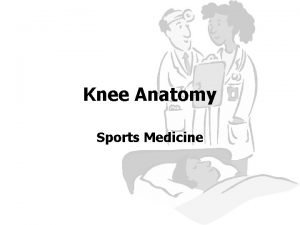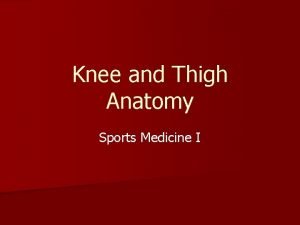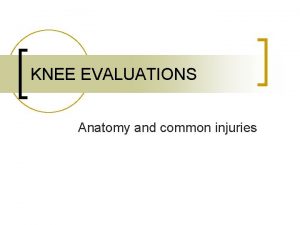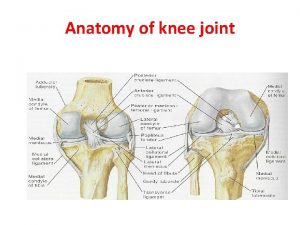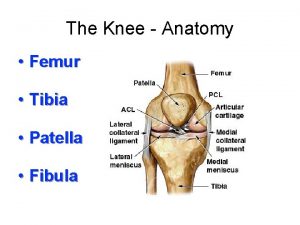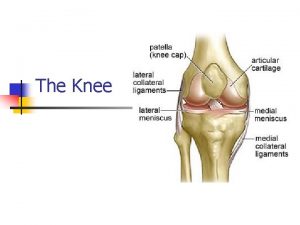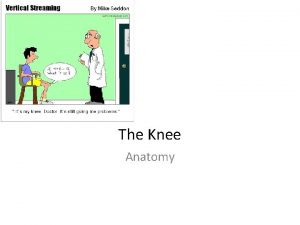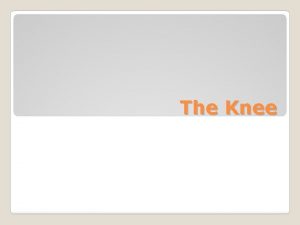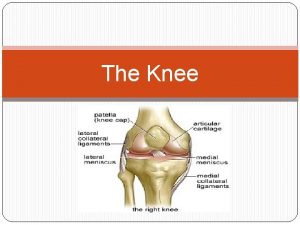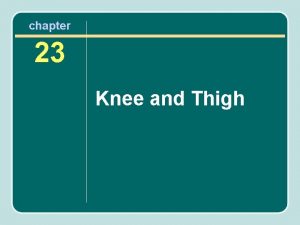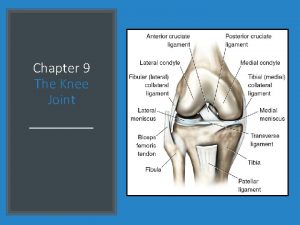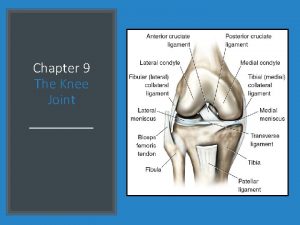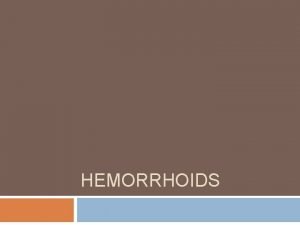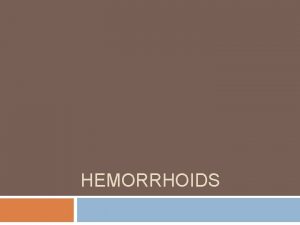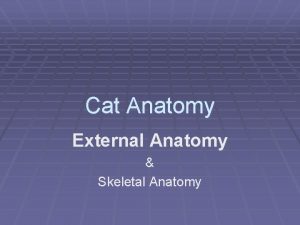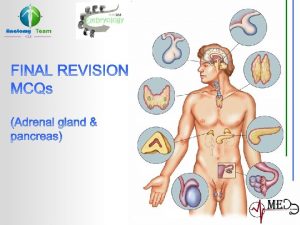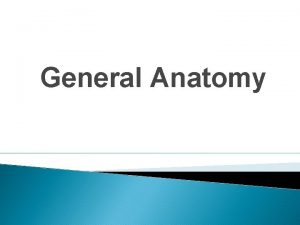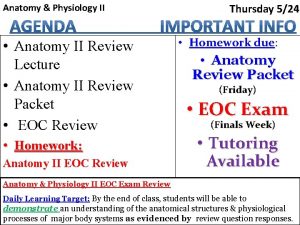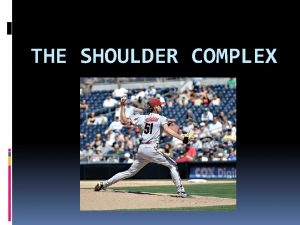CHAPTER 20 THE KNEE ANATOMY OF THE KNEE































































- Slides: 63

CHAPTER 20 THE KNEE

ANATOMY OF THE KNEE • BONE: - Femur: superior, largest bone in the body - Patella: sesamoid bone - Tibia: inferior and medial to the knee - Fibula: inferior and lateral to the knee


MENISCI • The menisci are two oval fibrocartilages • Cushion the head of the tibia and the head of the fibula • Medial meniscus: C-shaped • Lateral meniscus: O-shaped


STABILIZING LIGAMENTS • Include cruciate and collateral ligaments • Cruciate: -ACL: Anterior Cruciate ligament * attaches below and in front of the tibia; then passes backward, attachin to lateral condyle. *Commonly injured in females *Surgically repaired

PCL • PCL: Posterior Cruciate Ligament *Stronger of the 2, crosses from the back of tibia in the upward, forward and medial direction and attaches to the medial condyle of the femur. * Is not usually surgically repaired - lack of blood supply makes repairing difficult

THE COLLATERAL LIGAMENTS • MCL: Medial Collateral Ligament -Attaches on medial side of femur to medial head of tibia. - Heals on its own, not usually surgically repaired • LCL: Lateral Collateral Ligament -Attaches to the lateral condyle and lateral head of fibula


JOINT CAPSULE • Includes, bones, ligaments, meniscus, muscles, tendons, bursa, fat pads and synovial fluid • Largest joint capsule in the body

KNEE MUSCULATURE • FLEXION: Hamstrings (biceps femoris, semitendonosus, semimembranosus), gastrocnius, gracilis, sartorius, plantaris and politeus. - all muscles and posterior side of body * EXTENSION: Quadriceps (rectus femoris, vastus medialis, vastus intermedius, and vastus lateralis). All on anterior side

Anterior muscles extension

Posterior muscles. . flexion

NERVE AND BLOOD SUPPLY • Nerves: Tibial nerve, Femoral nerve and the peroneal nerve • Blood supply: Popliteal artery and femoral artery.

ACTIONS OF THE KNEE • • • FLEXION EXTENSION ROTATION GLIDING ROLLING

HOPS • HISTORY: What, where and when • OBSERVATION: What do you see? - Walking - Leg alignment - Patellar orientation: * Genu Valgum: knocked knee * Genu Varum: bowlegged * Genu recurvation: hyperextended knees

Genu valgum Knocked knee Genu varum bowlegs Genu recurvatum hyperextended knees

HOPS • PALPATION: BONEY PALPATION - BONES: patella tibial plateau head of the fibula condyls of femur - SOFT TISSUE: Quads, Hamstring, Gastroc Ligaments (ACL, PCL, MCL, LCL) Meniscus

HOPS • SPECIAL TESTS: ROM - Anterior/posterior Draw test: cruciate ligaments - Lachman’s Test: Cruciate ligaments - Pivot shift test: ACL injury - Valgus/varus stress test: Collateral ligaments - Meniscal test: Mc. Murrays test, Apley’s compression and distraction tests

Anterior draw test Posterior draw test

Lachman’s Test

Lachman’s Test

Mc. Murray’s Meniscus test

Apley’s Compression and Distraction test

FUNCTIONAL EXAMINATION • Patellar Exam: -Q angle: angle between the hips and the patella. Normal is 10 degrees for males 15 degrees for females - If angle is in excess of 20 degrees it is considered to be abnormal - A angle: Measures the patellar orientation of the tibial tubercle. 35 degrees or greater causes injury.

Q ANGLE A ANGLE

FUNCTIONAL EXAM • Palpation of patella:

FUNCTIONAL EXAM • Patellar compression, Patellar grinding and Apprehension Tests Patellar compression Patellar grinding

Apprehension Test

PREVENTION OF KNEE INJURIES • Physical conditioning and rehabilitation • ACL injury prevention program - strengthening of Quad, Ham and Gastroc - Proprioceptive balance board training - Neuromuscular training: wt lifting, landing cues, stretching and plyometric training - Intervention programs: strength, balance, and technique training. lilly

KNEE INJURIES • LIGAMENT INJURIES: -ACL, PCL, MCL AND LCL SPRAINS -Special tests: Draw tests - Lachman’s Test - Valgus/varus stress tests - ROM

INJURY PREVENTION • Shoe type • Functional and prophylactic knee braces

GRADES • GRADE 1 SPRAIN: - a few ligamentous fibers are torn and stretched - the joint is stable during valgus stress test - there is little or no joint effusion(swelling) - There may be some joint stiffness and point tendernesslilly


Grade 1 sprain of MCL

GRADE 2 SPRAIN • Complete tear of the deep capsular ligament and a partial tear of the superficial layer of the MCL or ligament • No gross instability, min. laxity during full extension • Moderate swelling and severe joint tightness • Definite loss of ROMlilly

GRADE 3 • Complete loss of stability • Min. to moderate swelling • Immediate severe pain followed by a dull ache • Loss of motion

Grade 3 rupture of the ACL

INJURIES TO THE KNEE • Meniscal Lesions: tears to cartilage • Knee plica: fetus has 3 synovial cavities in the knee. . Adults have 1. When the body fails to absorb the cavities leftover septa (dividers) form synovial folds (plica) • Osteochondral knee fractures: ligament tears it shears off part of the chondyl of the femur

MENISCAL TEAR

KNEE PLICA

Osteochondral knee fractures

JOINT INJURIES • Osteochondritis Dissecans: partial or complete separation of a piece of articular cartilage and subchondral bone. • Loose bodies within the knee • Joint contusions • Bursitis


Loose bodies within the knee

Patella bursitis

PATELLAR CONDITIONS • Patellar fracture • Acute patellar subluxation or dislocation: -sublux: patella goes in and out on its own -dislocation: patella goes out and stays out *Chondromalacia: softening of articular cartilage. *Patellaofemoral stress syndrome: inflam of the tendon above and below the patella

PATELLAR FRACTURE

PATELLA SUBLUXATION/DISLOCATION

CHRONDOMALACIA OF PATELLA

PATELLOFEMORAL STRESS SYNDROME

OTHER INJURIES • Osgood-Schlatter disease: occurs in teens between 12 -15 years of age • Larsen-Johansson Disease • Patellar tendonitis: jumper’s or kicker’s knee • Patellar tendon rupture • Runner’s knee: cyclist’s kneelilly

OSGOOD-SCHLATTER’S DISEASElilly

LARSEN-JOHANSSON DISEASElilly

JUMPER’S OR KICKER’S KNEElilly

PATELLAR TENDON RUPTURElilly

ITB FRICTION SYNDROME OR RUNNER’S KNEE

KNEE JOINT REHAB • • • General body conditioning Weight bearing Knee Joint Mobilization Flexibility: ROM Muscular strength: flexion, extension, abduction, adduction… • Neuromuscular control





FUNCTIONAL TESTING • Walking: forward, backward, straight line, curve. • Progress to jogging: forward, backward, uphill, downhill, and curves • Running • Sprinting • Figure 8’s • RETURN TO ACTIVITYlilly
 Makenzie milton injury
Makenzie milton injury Knee anatomy chapter 16 worksheet 1 answer key
Knee anatomy chapter 16 worksheet 1 answer key Mid inguinal point
Mid inguinal point Knee joint anatomy
Knee joint anatomy Chapter 16 worksheet the knee and related structures
Chapter 16 worksheet the knee and related structures Hình ảnh bộ gõ cơ thể búng tay
Hình ảnh bộ gõ cơ thể búng tay Frameset trong html5
Frameset trong html5 Bổ thể
Bổ thể Tỉ lệ cơ thể trẻ em
Tỉ lệ cơ thể trẻ em Voi kéo gỗ như thế nào
Voi kéo gỗ như thế nào Tư thế worm breton là gì
Tư thế worm breton là gì Hát lên người ơi
Hát lên người ơi Các môn thể thao bắt đầu bằng tiếng bóng
Các môn thể thao bắt đầu bằng tiếng bóng Thế nào là hệ số cao nhất
Thế nào là hệ số cao nhất Các châu lục và đại dương trên thế giới
Các châu lục và đại dương trên thế giới Công thức tính độ biến thiên đông lượng
Công thức tính độ biến thiên đông lượng Trời xanh đây là của chúng ta thể thơ
Trời xanh đây là của chúng ta thể thơ Mật thư anh em như thể tay chân
Mật thư anh em như thể tay chân 101012 bằng
101012 bằng độ dài liên kết
độ dài liên kết Các châu lục và đại dương trên thế giới
Các châu lục và đại dương trên thế giới Thơ thất ngôn tứ tuyệt đường luật
Thơ thất ngôn tứ tuyệt đường luật Quá trình desamine hóa có thể tạo ra
Quá trình desamine hóa có thể tạo ra Một số thể thơ truyền thống
Một số thể thơ truyền thống Bàn tay mà dây bẩn
Bàn tay mà dây bẩn Vẽ hình chiếu vuông góc của vật thể sau
Vẽ hình chiếu vuông góc của vật thể sau Biện pháp chống mỏi cơ
Biện pháp chống mỏi cơ đặc điểm cơ thể của người tối cổ
đặc điểm cơ thể của người tối cổ V. c c
V. c c Vẽ hình chiếu đứng bằng cạnh của vật thể
Vẽ hình chiếu đứng bằng cạnh của vật thể Phối cảnh
Phối cảnh Thẻ vin
Thẻ vin đại từ thay thế
đại từ thay thế điện thế nghỉ
điện thế nghỉ Tư thế ngồi viết
Tư thế ngồi viết Diễn thế sinh thái là
Diễn thế sinh thái là Các loại đột biến cấu trúc nhiễm sắc thể
Các loại đột biến cấu trúc nhiễm sắc thể Bảng số nguyên tố lớn hơn 1000
Bảng số nguyên tố lớn hơn 1000 Tư thế ngồi viết
Tư thế ngồi viết Lời thề hippocrates
Lời thề hippocrates Thiếu nhi thế giới liên hoan
Thiếu nhi thế giới liên hoan ưu thế lai là gì
ưu thế lai là gì Hổ đẻ mỗi lứa mấy con
Hổ đẻ mỗi lứa mấy con Sự nuôi và dạy con của hươu
Sự nuôi và dạy con của hươu Sơ đồ cơ thể người
Sơ đồ cơ thể người Từ ngữ thể hiện lòng nhân hậu
Từ ngữ thể hiện lòng nhân hậu Thế nào là mạng điện lắp đặt kiểu nổi
Thế nào là mạng điện lắp đặt kiểu nổi Chapter 14 anatomy and physiology
Chapter 14 anatomy and physiology Chapter 1 introduction to human anatomy and physiology
Chapter 1 introduction to human anatomy and physiology Anatomy and physiology chapter 8 special senses
Anatomy and physiology chapter 8 special senses Chapter 13 anatomy and physiology of pregnancy
Chapter 13 anatomy and physiology of pregnancy Anatomy and physiology chapter 2
Anatomy and physiology chapter 2 Chapter 7 anatomy and physiology
Chapter 7 anatomy and physiology Chapter 14 the digestive system and body metabolism
Chapter 14 the digestive system and body metabolism Chapter 10 blood anatomy and physiology
Chapter 10 blood anatomy and physiology Anatomy and physiology chapter 15
Anatomy and physiology chapter 15 Anatomy and physiology chapter 1
Anatomy and physiology chapter 1 Holes anatomy and physiology chapter 1
Holes anatomy and physiology chapter 1 Gi tract histology
Gi tract histology Chapter 6 general anatomy
Chapter 6 general anatomy Chapter 1 introduction to human anatomy and physiology
Chapter 1 introduction to human anatomy and physiology Chapter 2 human reproductive anatomy and physiology
Chapter 2 human reproductive anatomy and physiology Pectoral girdle acetabulum
Pectoral girdle acetabulum Chapter 6 general anatomy and physiology
Chapter 6 general anatomy and physiology
